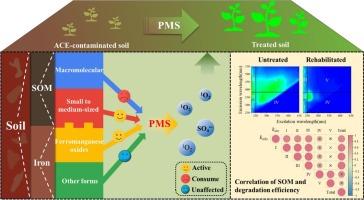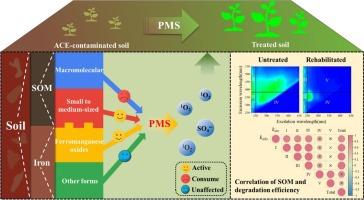Dual effects of organic matter in the remediation of acetaminophen-contaminated soil by peroxymonosulfate
IF 13.2
1区 工程技术
Q1 ENGINEERING, CHEMICAL
引用次数: 0
Abstract
Soil organic matter (SOM) is a critical component of soil, but its impact on the efficacy and mechanism of peroxymonosulfate (PMS)-based soil remediation technology has not been fully elucidated. This study revealed that SOM exerts dual effects in the remediation of acetaminophen (ACE)-contaminated soil by PMS, where both excessive and insufficient SOM levels can adversely impact ACE degradation efficiency. Protein-like and fulvic-like substances critically enhance ACE elimination by activating PMS when their volume ranges from 75.8 % to 87.2 %. Additionally, in the presence of PMS, humic-like substances can be converted into protein-like and fulvic-like substances. Ferromanganese oxide and amorphous iron also facilitate the degradation of ACE, with ferromanganese oxide playing a more significant role. The study identified singlet oxygen (1O2) and sulfate radicals (SO4•−) as the primary reactive oxygen species (ROS) responsible for the elimination process. Furthermore, the degradation rate of ACE indicated superior treatment efficacy under diverse pH conditions. The presence of Cl− was noted to partially inhibit the degradation of ACE, while HCO3−, Fe3+, and Mn2+ were observed to enhance the elimination process. Humic acid (HA) demonstrated a dual effect, while the impacts of NO3− and SO42− on the system were relatively minor. The degradation intermediates were characterized, and their toxicity was evaluated through phytotoxicity assays. This study systematically revealed the dual role of SOM and provided novel insight into the application of PMS in soil remediation.


有机物质在过氧单硫酸盐修复对乙酰氨基酚污染土壤中的双重作用
土壤有机质(SOM)是土壤的重要组成部分,但其对基于过氧单硫酸盐(PMS)的土壤修复技术的效果和机制的影响尚未完全阐明。本研究发现,SOM在PMS修复对乙酰氨基酚(ACE)污染土壤中具有双重作用,SOM水平过高和不足都会对ACE的降解效率产生不利影响。当蛋白质样物质和黄嘌呤样物质的体积在75.8% %到87.2 %之间时,它们通过激活PMS来促进ACE的消除。此外,在PMS存在的情况下,腐殖质样物质可以转化为蛋白质样物质和腐殖酸样物质。氧化锰铁和无定形铁也有利于ACE的降解,其中氧化锰铁的作用更为显著。该研究确定单线态氧(1O2)和硫酸盐自由基(SO4•−)是主要的活性氧(ROS),负责消除过程。此外,ACE的降解率在不同的pH条件下显示出较好的处理效果。发现Cl−的存在部分抑制了ACE的降解,而HCO3−、Fe3+和Mn2+的存在则促进了ACE的消除过程。腐植酸(HA)具有双重作用,而NO3−和SO42−对系统的影响相对较小。对降解中间体进行了表征,并通过植物毒性试验对其毒性进行了评价。本研究系统揭示了土壤有机质的双重作用,为土壤有机质在土壤修复中的应用提供了新的思路。
本文章由计算机程序翻译,如有差异,请以英文原文为准。
求助全文
约1分钟内获得全文
求助全文
来源期刊

Chemical Engineering Journal
工程技术-工程:化工
CiteScore
21.70
自引率
9.30%
发文量
6781
审稿时长
2.4 months
期刊介绍:
The Chemical Engineering Journal is an international research journal that invites contributions of original and novel fundamental research. It aims to provide an international platform for presenting original fundamental research, interpretative reviews, and discussions on new developments in chemical engineering. The journal welcomes papers that describe novel theory and its practical application, as well as those that demonstrate the transfer of techniques from other disciplines. It also welcomes reports on carefully conducted experimental work that is soundly interpreted. The main focus of the journal is on original and rigorous research results that have broad significance. The Catalysis section within the Chemical Engineering Journal focuses specifically on Experimental and Theoretical studies in the fields of heterogeneous catalysis, molecular catalysis, and biocatalysis. These studies have industrial impact on various sectors such as chemicals, energy, materials, foods, healthcare, and environmental protection.
 求助内容:
求助内容: 应助结果提醒方式:
应助结果提醒方式:


